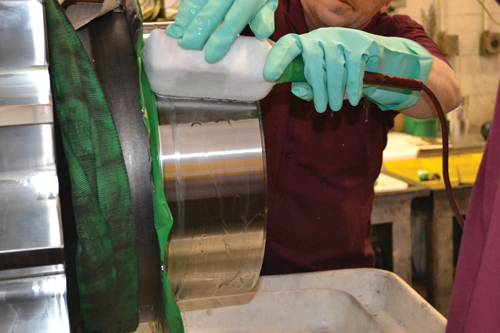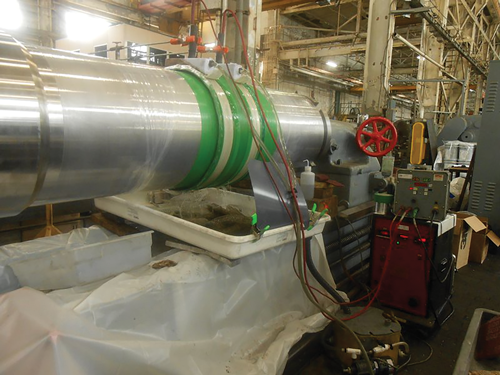Localizing a Surface Solution
The application potential and benefits of selective brush plating.
There are many benefits to choosing selective plating, including the ability to accurately focus the plating onto specific areas of a component, enabling parts to be plated in-situ and helping to minimize downtime and production delays.
Selective plating is best suited for localized areas on simple shapes, such as inside and outside diameters or flat surfaces. In contrast to tank plating, selective plating does not require extensive masking or special fixtures to plate the component. The length of time a plating operation will take is primarily determined by the amount of material that needs to be applied. Deposits can be plated at rates 30 to 60 times faster than conventional tank plating.
The performance and cost differences that these factors can make to maintaining, enhancing or repairing critical components can be significant, hence why it is important to consider all of the variables involved before deciding which surface finishing process to specify.

Not Just Repair
While damage from wear, corrosion or mis-machining can be repaired using selective brush plating, selective plating shouldn’t just be considered for cases of repair or salvage. The full range of pure metal and alloy deposits available with selective plating offers enhanced wear resistance, increased surface hardness, low electrical contact resistance or corrosion protection for a whole range of OEM component applications.
Initially used for industrial repair applications, selective plating was invented more than 50 years ago. With early acceptance by the U.S. Navy, over the years, the process has evolved to service an array of industrial and manufacturing applications.
The variety of metals used in selective plating is extensive. It is used to apply any metals that are traditionally carried out by tank electroplating, the most common being nickel, copper, cobalt, nickel-tungsten, cobalt chromium carbide, silver, gold and platinum.
There are several preparatory steps by which a work area is prepared to receive an adherent deposit. The appropriate procedure is determined by both the substrate of the component and the plating solution to be applied. The process can be carried out manually, mechanized, or automated for high-volume applications. The thickness of the plating is accurately controlled through use of an ampere-hour meter and once the required ampere hours are reached, plating is stopped and finished with a final water rinse and dry.
Aerospace, oil and gas and power generation are all industries that are highly demanding when it comes to surface finishing performance requirements. So how is the process used within these industries?

Selective plating is best suited for localized areas on simple shapes such as inside and outside diameters or flat surfaces.
Oil and Gas
The oil and gas industry is highly demanding of material performance, operating in hostile, challenging environments, where the cost of component failure can be extremely high. Selective plating is well proven, and extensively used, within the oil and gas industry in a range of applications from OEM component manufacture for enhanced wear or corrosion resistance, to repair, where the process portability is important in reducing expensive downtime. Let’s look at some specific application examples.
One common application is silver plating onto dynamic sealing and bearing surfaces in drill bit components for lubricity.
Another common application is the use of selectively plated copper, which is applied onto premium threaded connections, alloy premium drill pipe, risers, tubulars and couplings in order to prevent galling during make-and-break operations. The process is approved by industry leaders to apply these critical deposits as well as to train operators from approved companies worldwide to apply copper onto premium threaded connections.
For oil and gas producing operations, there is no escaping the challenge of corrosion due to the harsh environment deep in the ocean. The properties of certain nickel applications make it an extremely popular material to be selectively plated with high-chloride in down-hole applications. Additionally, surfaces that are mechanically damaged are often plated with a combination of copper and nickel. (Continued on p. 26)
(Continued from p. 23) One example of an in-situ repair is when an electroplater specializing in selective plating repaired critical damage caused by a lightning strike to a crown-mounted compensator (CMC) on an oil rig in the Gulf of Mexico. The CMC is responsible for applying constant tension to the drill string and to compensate for any rig movement. The significant gouge on the cylinder caused by the lightning strike would cause severe leakage at the cylinder seals, threatening production and the loss of thousands of dollars for each hour of downtime.
Using aerospace nickel for corrosion protection and cobalt 2043 to cap the repair for hardness and to protect against surface wear, the CMC was back in full operation within 24 hours—as opposed to the three months it would have taken to replace the shaft.

Outside diameter repair applying nickel on a component for dimensional restoration.
Aerospace
The aerospace industry is renowned for its robust standards for the manufacture and repair of its high performance equipment. Components need to be able to withstand friction, extreme temperatures and corrosive environments while continuing to operate at optimum levels.
The aerospace industry was one of the first to adopt selective plating for repair touch-ups to restore metal components that had been damaged by wear or corrosion. It is a widely accepted and approved method used to apply engineered deposits for both OEM and repair applications. A good example is the Federal Aviation Administration’s Advisory Circular 43.13-1B, which contains methods, techniques and practices (including selective plating) acceptable for the inspection and repair of non-pressurized areas of civil aircraft when there are no manufacturer repair or maintenance instructions. Selective plating is also approved worldwide by most major airlines, landing gear and engine manufacturers, and is written in to their overhaul manuals and standard practices.
Most companies work closely with customers in the aerospace industry to offer practical, cost-effective options for repairing and enhancing the surfaces of components. A great example is the travel kits provided for touch-up applications, specifically designed for the aerospace industry and ideal for aircraft on ground (AOG) operations where time is critical.
Common uses of selective plating include the application of cadmium and zinc-nickel for corrosion protection on structural components, as well as the application of nickel, which is used for prebraze applications in engine components. Companies offer a variety of nickel and nickel-alloy deposits with characteristics suitable for the range of conditions within the aerospace industry.

On-site repair on an outside diameter of an industrial component.
Power Generation
Components operating in the power generation industry are subject to intense environments and can be subject to heat, pressure, corrosion, wear, galling and friction. Selective plating offers a range of engineered deposits to enhance localized surfaces on OEM components and to repair equipment operating in these harsh conditions.
Selective plating presents an efficient and cost effective process that enables repair and maintenance work to be carried out on site without the use of an immersion tank. The mobility of selective plating enables large parts and components to be repaired in-situ, without the disruption and logistical challenges of having to remove and ship large and often expensive parts to a purpose-built facility. The process presents a sustainable solution for the repair and maintenance of parts versus alternative methods.
With the combination of specially designed, portable machining equipment and plating technology, most electroplaters using selective plating can repair damaged bearing journals and slip rings while in situ, eliminating the major delays associated with full disassembly and shipping. In one such case, the slip rings on a wind turbine were repaired, requiring three plated layers of copper, each approximately 0.015-inch thick, to resize the worn diameters. And then, after machining the plated copper deposit, 0.005-inch-thick layer of silver was plated to improve conductivity.
Automating for High Volume
Selective plating is a precise and effective method for the enhancement of localized surfaces on OEM components and can be mechanized or fully automated to meet the demands of high-volume plating applications.
Recently, a semi-automated workstation was developed for Powell Electrical Systems Inc., a division of Delta/Unibus, which reduced the processing time to selectively plate non-cyanide silver onto each side of its copper bus bars by 90 percent.
Its portability and versatility has allowed selective plating to be employed in some of most challenging locations and applications around the world, including submarines, space stations, hydro-electric power stations, nuclear power plants, oil rigs in remote locations and on critical aircraft components.
Selective brush plating has dramatically evolved from its origins of touching up existing plating jobs, and is now considered an overarching term describing a highly technical process used for repairing or improving the surface properties in an array of circumstances. It is specified in the initial engineering design as well as being called out for component repair.
The various advantages provided by the selective plating, combined with the variety of engineered deposits, make it an attractive choice for OEM and repair applications. Whatever the requirements or size of a job, selective plating should always be considered a viable alternative to other methods of metal deposition.
Derek Vanek is with Sifco ASC. For more information, visit sifcoasc.com.
Related Content
Top Shop Aces Outstanding Customer Service
More than a finishing shop, this anodizing, powder coating and vacuum resin impregnating business goes above and beyond for its customers by being a resource for whatever their finishing needs might demand.
Read MoreA Smooth Transition from One Anodizing Process to Another
Knowing when to switch from chromic acid anodizing to thin film sulfuric acid anodizing is important. Learn about why the change should be considered and the challenges in doing so.
Read MoreFinisher’s ‘Top Shop’ Status Attracts Business
This competitive California finisher made it a goal to become a PF Top Shop. After earning the recognition, the company experienced an immediate increase in business and a challenge to obtain certifications.
Read MoreUnderstanding PEO Coatings
Using high-speed cameras and back side illumination (BSI) sensor technology to analyze plasma electrolytic oxidation.
Read MoreRead Next
Selective Brush Plating a Tin-Zinc Alloy for Sacrificial Corrosion Protection
A tin-zinc selective brush plated coating has been developed to provide sacrificial corrosion protection without the use of toxic chemicals.
Read MoreEpisode 45: An Interview with Chandler Mancuso, MacDermid Envio Solutions
Chandler Mancuso, technical director with MacDermid Envio discusses updating your wastewater treatment system and implementing materials recycling solutions to increase efficiencies, control costs and reduce environmental impact.
Read MoreEducation Bringing Cleaning to Machining
Debuting new speakers and cleaning technology content during this half-day workshop co-located with IMTS 2024.
Read More





















